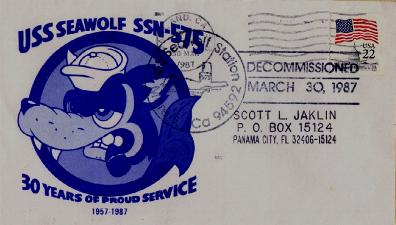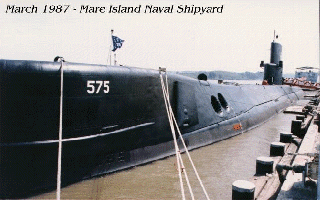

In June 1961, SEAWOLF got underway with the famous "Blue Angels" precision flying team embarked. During this indoctrination cruise, SEAWOLF demonstrated a series of underwater acrobatic maneuvers commonly referred to as "angles and dangles."
In 1963, SEAWOLF participated in the search for the lost USS THRESHER (SSN 593). In the spring of 1964, SEAWOLF deployed to the Mediterranean Sea and operated as a member of the world's first Nuclear Task Force. She operated with the USS ENTERPRISE (CVAN 65), USS LONG BEACH (CGN 9), and the USS BAINBRIDGE (CGN 25).
From 1965 to 1967, SEAWOLF was again refueled and upgraded to the new submarine quality assurance requirements that were set in place after the USS THRESHER (SSN 593) tragedy. She also became the Flagship of Submarine Squadron Two.
On November 17, 1970, SEAWOLF transited the Panama Canal coinciding with her change of home port from Groton, Connecticut to Mare Island Naval Shipyard in Vallejo, California for conversion to a special project platform.
In 1974, SEAWOLF completed her extensive post-conversion testing and evaluation period and conducted her first Pacific Fleet deployment which included operating independently for a period of three months. For her performance of duty, she was awarded second Navy Unit Commendation. In 1975, SEAWOLF came under the exclusive direction of Submarine Development Group One, and for outstanding performance in 1974-1975, was awarded a Battle Efficiency "E".
In 1976, SEAWOLF received her second consecutive Battle Efficiency "E" and the Engineering "E" for Excellence. During her second Pacific Fleet deployment, she conducted independent submerged operations for three months and demonstrated superior endurance by remaining submerged for 87 consecutive days, a U.S. Navy record. She received her third Navy Unit Commendation.
In 1977, SEAWOLF received her third Battle Efficiency "E" and her second Engineering "E" for Excellence. During her third Pacific Fleet deployment, she conducted 79 consecutive days of independent submerged operations and received her fourth Navy Unit Commendation and the Navy Expeditionary Medal.
In 1978, SEAWOLF conducted her fourth Pacific Fleet deployment.
In August 1981, SEAWOLF deployed on her fifth Pacific Fleet deployment. She returned to homeport in October 1981 and received the Navy Expeditionary Medal.
In 1983, SEAWOLF conducted her sixth Pacific Fleet deployment of 76 days and returned to Mare Island Naval Shipyard in May 1983. She was awarded the Navy Expeditionary Medal, another Battle Efficiency "E", another Engineering "E", a Supply "E", and a Damage Control "DC".
In 1984, SEAWOLF conducted a 93-day deployment to the Western Pacific, returned in July, and continued her high operating tempo with numerous local operations. She was awarded her third consecutive Supply "E", a Communications "C", and the Deck Seamanship Award.
In April of 1986, SEAWOLF conducted her last successful Western Pacific deployment and returned to Mare Island in June of 1986 to prepare for decommissioning.
USS SEAWOLF (SSN 575) was decommissioned on March 30, 1987.


The SEAWOLF name was not retired. She was towed to Bremerton, Washington, where she was laid to rest before entering the submarine recycling program on September 30, 1997. From her launch date in 1955 she proudly served our nation over 32 years. The lead ship of the fast-attack submarine of the 21st century (the SSN 21 Class) is named SEAWOLF, carrying on her proud tradition of excellence.